After guiding Strasbourg to a safe, 15th place finish in Ligue 1 this past season, Thierry Laurey’s five-year spell as RC Strasbourg manager came to an end in late May. Less than a week after his departure, Les Coureurs announced that former Rennes boss Julien Stéphan would replace Laurey at Stade de la Meinau.
Stéphan’s more-than-two-year tenure in charge of Rennes, during which he guided the Brittany-based club to the UEFA Champions League, concluded in March following a difficult period of results for the club, with the 40-year-old coach explaining that his decision to resign was made “with a heavy heart”.
Looking ahead to the 2021/22 campaign, the highly-regarded manager’s new challenge begins with a club that finished the 2020/21 season nine places below his former club. However, when he initially took the reins at Roazhon Park, Rennes were in 14th place, so a similar position to the one Strasbourg ended last term in.
So, can Stéphan engineer similar growth at Strasbourg as he did at Rennes? In this tactical analysis piece, we’ll look into Strasbourg’s squad and how they may fit Stéphan’s potential tactics, while we’ll also provide some analysis of key aspects of Stéphan’s philosophy, based on his time at Rennes.
Stéphan’s philosophy
Stéphan ideally prefers to play a possession-based game. He has spoken openly in the past about his admiration for coaches in the ilk of Manchester City boss Pep Guardiola and new boss of Serie A side Lazio, Mauricio Sarri, describing these two managers as “sources of inspiration” both in terms of their implementation of the principles of positional play in possession, as well as their aggressive pressing in transition to defence.
The new Strasbourg boss slowly moved his Rennes side in this direction during his time at Roazhon Park, as is evident from the fact that they retained an average of 57.4% possession this past season, but just 49.5% the season before.
This change between the 2019/20 season and the 2020/21 season saw Rennes go from being a more transition-based side to a more possession-based side and one key part of achieving that was the addition of Steven Nzonzi to the squad, who spent the last 18 months on loan at Rennes from Roma.
Nzonzi played a very specific, key role in Stéphan’s side during his time at Rennes. This specifically saw him play a central role in Rennes’ possession game, with the vast majority of Rennes’ passes going through Nzonzi as the ‘6’. Thanks to his calmness and quality on the ball, Stéphan tasked Nzonzi with playing far more passes under pressure than any other Rennes player, as well as many of Rennes’ progressive passes.
Before acquiring Nzonzi, Rennes usually played with a double-pivot in either a 4-2-3-1 or a 4-4-2 with deep 6s and relied more on counter-attacks than positional attacks, whereas after signing Nzonzi, Rennes typically played with a 4-1-4-1 and relied more on positional attacks.
This highlights an important aspect of Stéphan’s philosophy and personality – he is flexible. The 40-year-old Frenchman has his ideal way of playing, which we’ve discussed, but as he’s put it himself in the past, “it is not possible to play Guardiola everywhere”. In other words, if the conditions aren’t right for Stéphan’s ideal style of play, he doesn’t force a certain style out of principle – he is adaptable and good at assessing the tools he has available to him before deciding on the best way to do the job. On arrival at Rennes, Stéphan stressed “pragmatism”, explaining that “for now, the team is based on solid foundations”, which only began to change over a year after his arrival.
So, the presence of a well-rounded 6 who can dictate play and two good ball-playing centre-backs are important for Stéphan, but regardless of whether his Rennes side were more possession-based or more transition-based, some aspects of Stéphan’s playing philosophy remained consistent, and this helps analyse how he’ll set up at Strasbourg.
Stéphan loves slow passing during the build-up phase, he loves positional fluidity in possession, he loves to create lots of options for the passers, through his team’s offensive shape which generally has several short passing options, a long passing option freeing himself up via a run in behind the opposition backline, and prioritises holding width on the opposite side of the pitch to create an option for a switch.
Strasbourg’s new manager could be described as a calculated risk-taker. If he judges the odds to be in his favour, then he’s happy for his players to take risks but he is cautious, first and foremost. This is why his teams tend to play lots of progressive passes during the ball progression and chance creation phases to try and open the opposition defence, but also always tend to have a very high pass completion rate – and progressive pass completion rate.
Stéphan wants his team to play accurate short passes first and foremost. His teams are very patient and cautious, so Strasbourg fans can expect a high pass completion to be prioritised with Stéphan, but where this manager excels is in his ability to get his team forging good progressive and creative passing options that aren’t very risky, through the shape and movement that his tactics create.
As his comments on Guardiola and Sarri would suggest, Stéphan loves his side to press aggressively in transition to defence, while his Rennes team was generally active and somewhat aggressive without the ball in the high block. We’ll take a closer look at the defensive tactics Stéphan has deployed in the past later in this tactical analysis, but it’s important to note that in addition to generally keeping a fairly low PPDA, Stéphan’s sides tend to prioritise control of the centre out of possession and will generally only press aggressively if they can do so while maintaining their compact shape and control of the centre.
However, game state affects this a lot. When trailing late on in a game, Stéphan is far more likely to risk losing control of the centre and committing more men to the aggressive, high press to try and win the ball in a more dangerous position. This is all part of the Frenchman’s calculated risk-taker nature.
Stéphan’s attack and how Strasbourg’s squad could fit specific roles
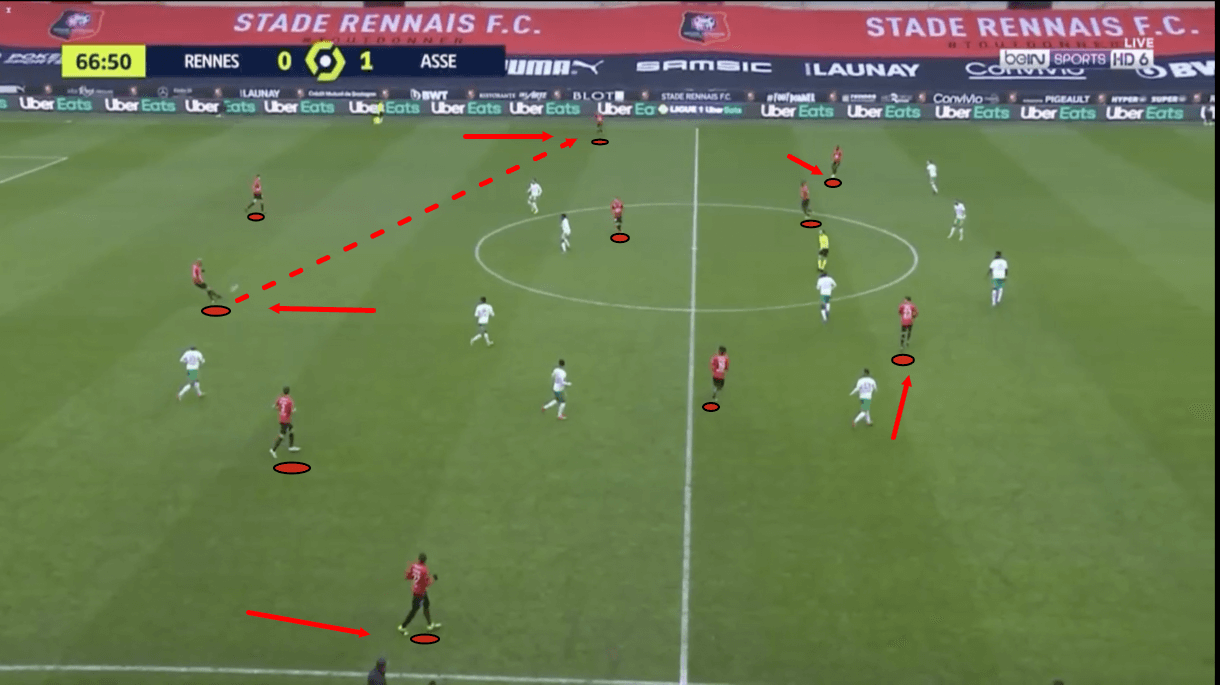
In figure 1, we see how Rennes typically lined up in possession under Stéphan, with Nzonzi usually operating in front of the two centre-backs but sometimes dropping in between them, the full-backs advancing to provide width, the wingers coming inside, forming a box with Rennes’ 8s.
This shape tells us a lot about Stéphan’s principles of play in possession. Firstly, in ball progression, Rennes generally utilised either a 3-2 base with the 6 dropping in between the centre-backs and the 8s holding their position, or a 2-1-2 central shape with the 6 linking the centre-backs to the 8s who would sit higher. This shape created lots of short passing options for the centre-backs and the 6.
The full-backs would tend to hold width on their respective wing regardless of which side the ball was on, to make themselves available for the switch, which Stéphan liked his side to hit regularly after overloading the opposite wing, while the front three would offer different forward passing options via their alternating movements. One of the attackers would make runs in behind, while another dropped deeper to create a different option for the ball carrier, for example.
Additionally, while Stéphan doesn’t like his side to play many long balls, and Strasbourg fans should expect far fewer long balls next term, he does like to give his ball carrier the option of doing so and generally plays a good aerial threat up front to facilitate this. Both Serhou Guirassy and M’Baye Niang performed this role at times during Stéphan’s Rennes tenure, and Strasbourg’s top goalscorer last season Ludovic Ajorque is a viable option for this role. The striker is very aerially dominant and can hold the ball up well.
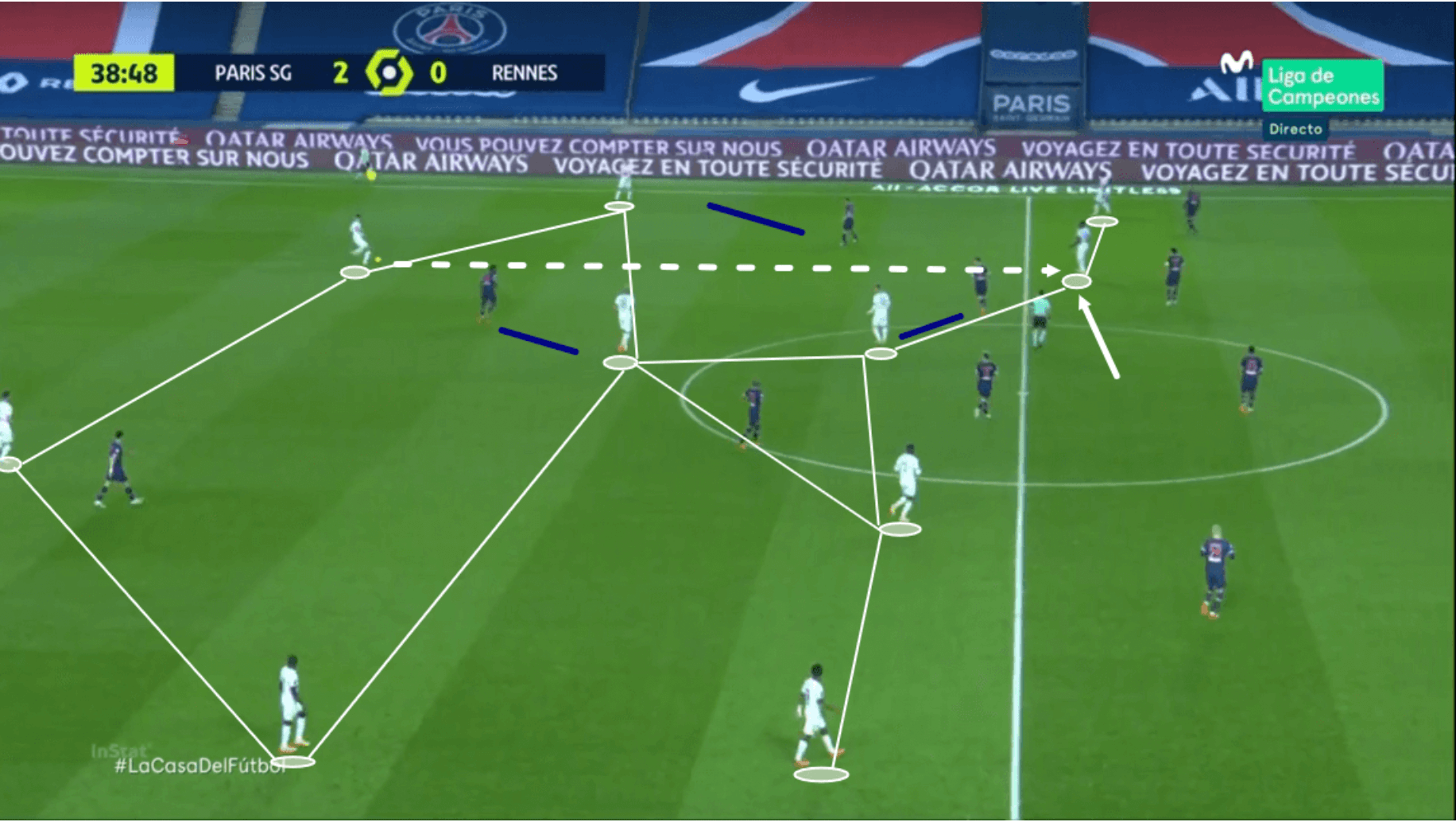
In figure 2, we see an example of Rennes’ build-up shape under Stéphan with Nzonzi positioned higher. The left centre-back had three short passing options near him, in the form of Nzonzi, the left-back, and the near-sided 8. However, he also had the longer passing option that the centre-forward offered by shifting over to the same vertical line as him. While the opposition marked the near passing options, they failed to deal with the centre-forward’s movement and this was the option that Rennes managed to progress through.
The far-sided 8 also began making a run in behind as this centre-forward shifted over to the left, dragging the opposition defence with him, highlighting how Stéphan’s side is constantly reacting to one another’s movements to create more options for the ball carrier. That is a key part of Stéphan’s offensive tactics – creating as many options for the ball carrier as possible, especially the centre-backs and 6 in the ball progression phase, with these players spending more time on the ball than any other player in Stéphan’s system. If a player isn’t one of the obvious short passing options, they are thinking about how they can become a long passing option.
Some of the biggest areas that Laurey’s Strasbourg stylistically differed from Stéphan’s Rennes are dribbles and pass types. Regardless of playing style, Stéphan’s Rennes generally made a lot more dribbles, progressive runs and short passes than Laurey’s Strasbourg, while Laurey’s Strasbourg tended to play far more long balls and make much fewer dribbles than Stéphan’s side. You could describe a Stéphan side as being much more careful than a Laurey side.
As mentioned, Stéphan prioritises pass completion in possession, which sees his side play a lot of short, accurate passes. This was particularly important amongst Rennes’ centre-backs and central midfielders. Stéphan would’ve undoubtedly liked working with Mohamed Simakan, who thrives in this area, however, the 21-year-old centre-back is on the move to Bundesliga side RB Leipzig this summer. As a result, perhaps centre-back is an area that Stéphan would like his new club to think about making acquisitions this summer, while it’s also possible that the 40-year-old, who is renowned for his work with young players, could introduce 22-year-old Duplexe Tchamba to Strasbourg’s first-team squad.
However, as a potential starting duo, assuming Stéphan sticks with a back-four as he has done in the past, Stefan Mitrović and Alexander Djiku are two centre-back options who perform very well in terms of pass completion, as well as aerial duel success which is an area that any manager will want his centre-backs to be strong. As a result, based on Strasbourg’s current options, Djiku as a right centre-back and Mitrović as a left centre-back seems a likely pairing that could suit Stéphan.
As for central midfield, none of Strasbourg’s midfielders pass as much as Nzonzi did for Rennes last season, as Laurey’s tactics put less of an emphasis on the 6 in build-up, ball progression, and even chance creation as Stéphan did. We want to highlight two players in particular when talking about the 6 role for Stéphan – Jean-Eudes Aholou and Sanjin Prcić.
Aholou is set to return to Monaco next season following his season-long loan at Strasbourg in the 2020/21 campaign, however, he performed well in terms of pass completion with Strasbourg last season, primarily playing as a 6, and so, he may not be a bad option for this position if Strasbourg can lure him back for another term. However, Aholou isn’t perfect for this position either, he’s not as well-rounded as a player like Nzonzi and doesn’t offer as much in terms of progressive passes, long passes, passes under pressure, or progressive carries. So there are still some question marks about his suitability.
Prcić, a former Rennes player, is a very interesting talking point looking ahead to Stéphan at Strasbourg, given that he hasn’t played regularly for any club since leaving Rennes in the 2017/18 campaign, enjoying just 345 league minutes for Les Coureurs last season. However, his profile would, in theory, suit a Stéphan side very well, in either the 6 position or a more advanced 8 position.
The Bosnia and Herzegovina international is an excellent progressive passer and long passer with a good pass completion rate, while he’s also a good ball carrier. Whether or not he has the defensive discipline and game-reading quality of an Nzonzi will likely be the deciding factor as to whether or not Prcić really can occupy the 6 position in this team but in terms of his on-the-ball quality, he presents a viable option and an exciting one, given his lack of prevalence in recent seasons.
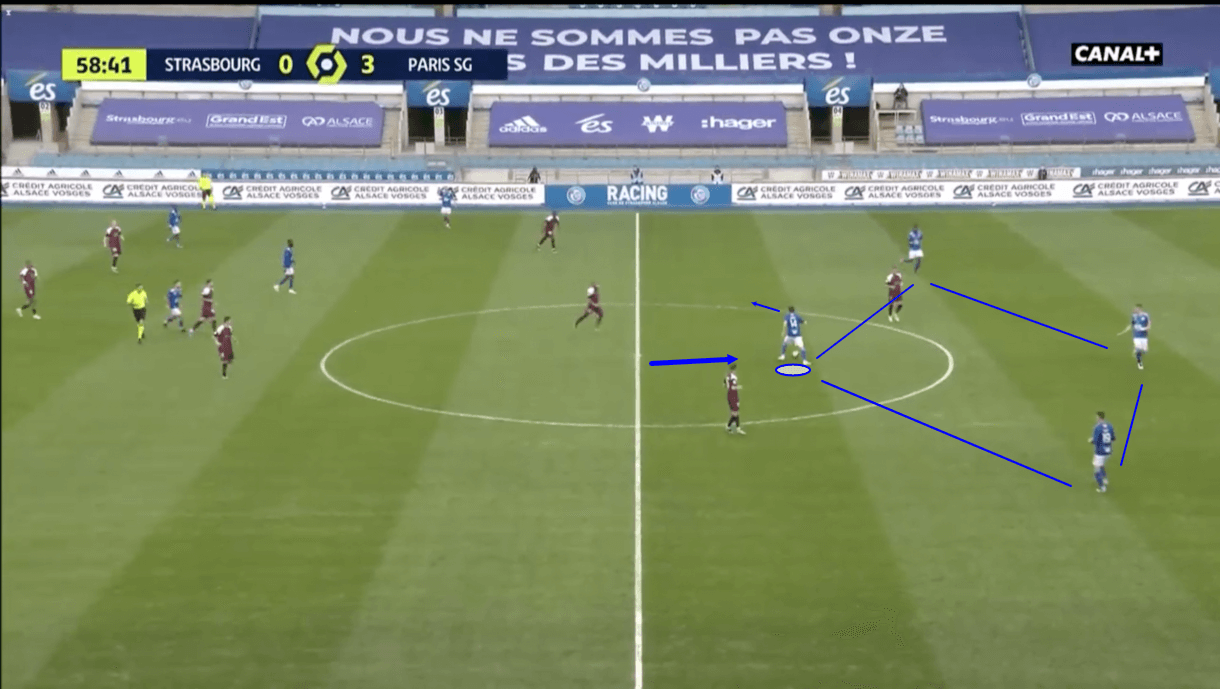
In figure 3, we see an example of Prcić playing as a 6 for Strasbourg last season in possession, however, he had a base of three centre-backs behind him. Stéphan has always played with two centre-backs, with the 6 sometimes dropping into the centre as a third centre-back during the ball progression phase, however, this 3-1 or even a 3-2 base could be more suitable if playing Prcić in the same role as Nzonzi is too risky and if Strasbourg are unable to sign a better option for the 6 role. Given Stéphan’s typical risk-aversion, we feel that this could be a likely move.
This 3-1 base could be achieved through playing three centre-backs or through shifting a full-back centrally in possession, which may be something Stéphan should consider with this Strasbourg side, as the full-backs currently at Stade de la Meinau don’t carry the ball upfield as much as his full-backs at Rennes did, especially since Kenny Lala’s departure. They do have good progressive passers, who haven’t proven to be great progressive carriers, at full-back, however, like left-back Anthony Caci, who could transition into an outside centre-back role in this particular phase.
Prcić is also very good at switching play, and while this was part of Nzonzi’s role at Rennes under Stéphan, it was very common to see the 8s, and Benjamin Bourigeaud in particular, switching play regularly under Stéphan. This was a result of Stéphan’s offensive tactics which saw his team overload one side of the pitch while having one player, either a winger or an overlapping full-back, holding the width on the underloaded side, ready to receive the switch.
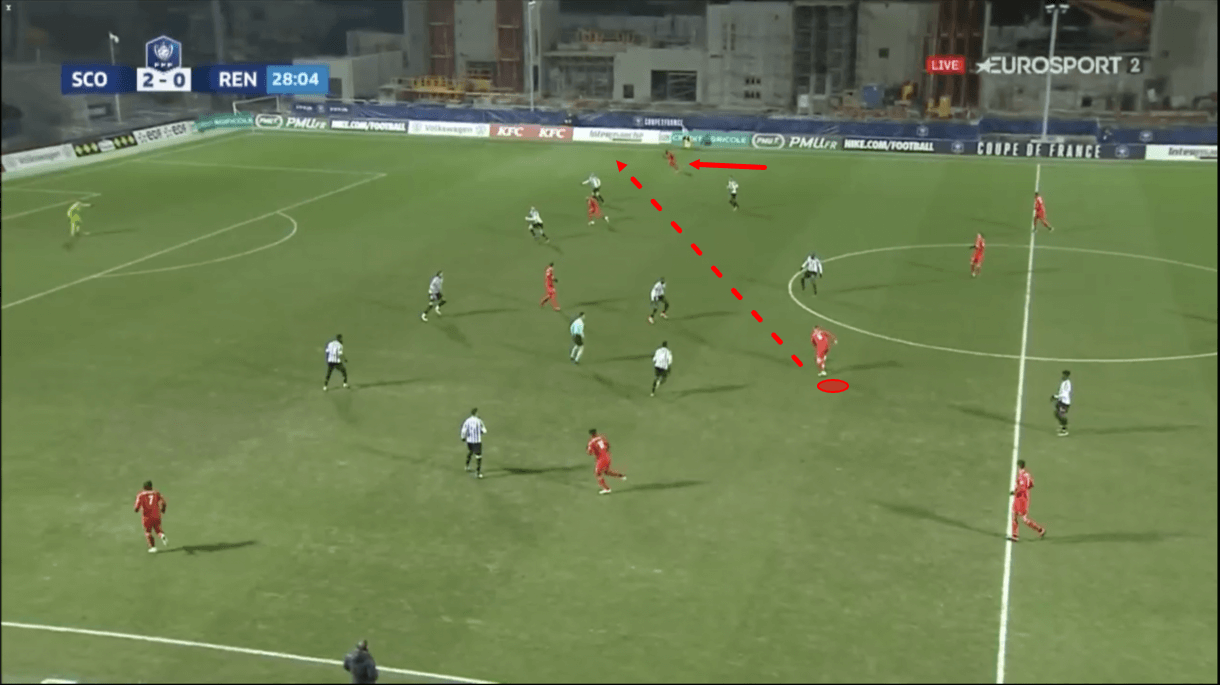
We see an example of Stéphan’s side pulling off a switch to the wide player holding width on the underloaded flank via Bourigeaud in figure 4. Yes, Stéphan loves lots of short accurate passes in all possession phases of play but that short passing is purposeful. One reason for that short passing is to overload one wing, draw the opposition over via quick, short passing interchanges while creating an opportunity to switch play. This is a result of Stéphan’s prioritisation of short, accurate passing which inevitably sees players position themselves closely together and his offensive shape which creates many options, both close and far, to the ball carrier. One of these options is always on the opposite wing, due to the width-providers positioning themselves very wide at all times to take advantage of opportunities like this.
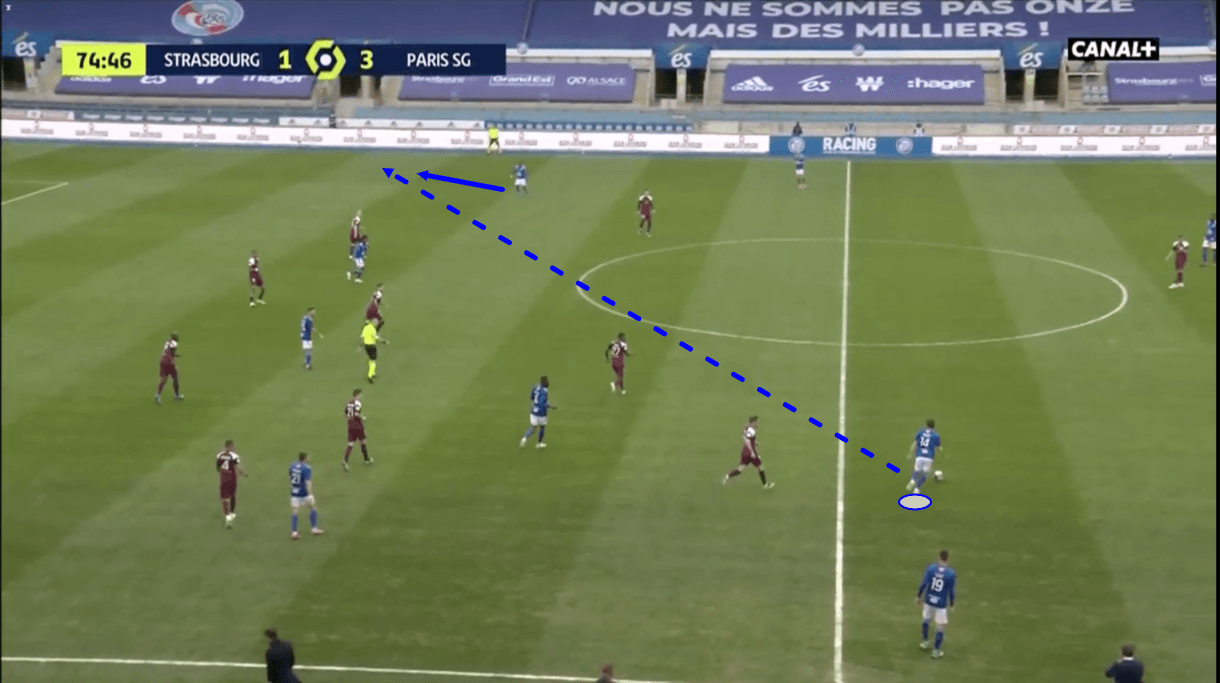
Figure 5 shows Prcić pulling off a switch in a similar style to Bourigeaud, in Strasbourg colours last season. He’s got the passing range, vision, and confidence to pull off passes like this regularly and this is something Stéphan will undoubtedly appreciate and want to use.
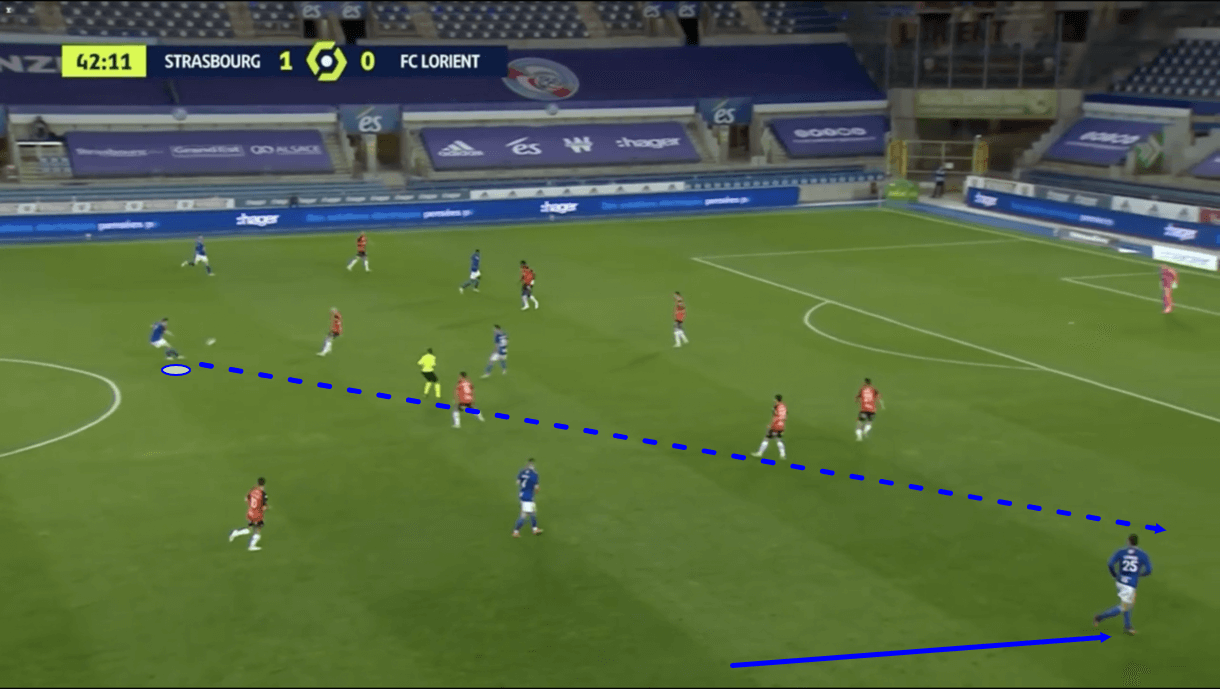
As well as Prcić, Dimitri Liénard loves playing these types of passes, having done so with Strasbourg frequently last season. Figure 6 shows Liénard switching play, again, from a similar position and in a similar situation to the ones Stéphan set up for Bourigeaud during his time at Rennes.
So, Strasbourg’s central midfielders offer qualities that Stéphan will appreciate. We feel that Liénard and Prcić should both have an important role in this squad, as either two 8s with a Nzonzi-style 6 behind them or as a double-pivot in either a 4-4-2 with deep 6s or a 4-2-3-1.
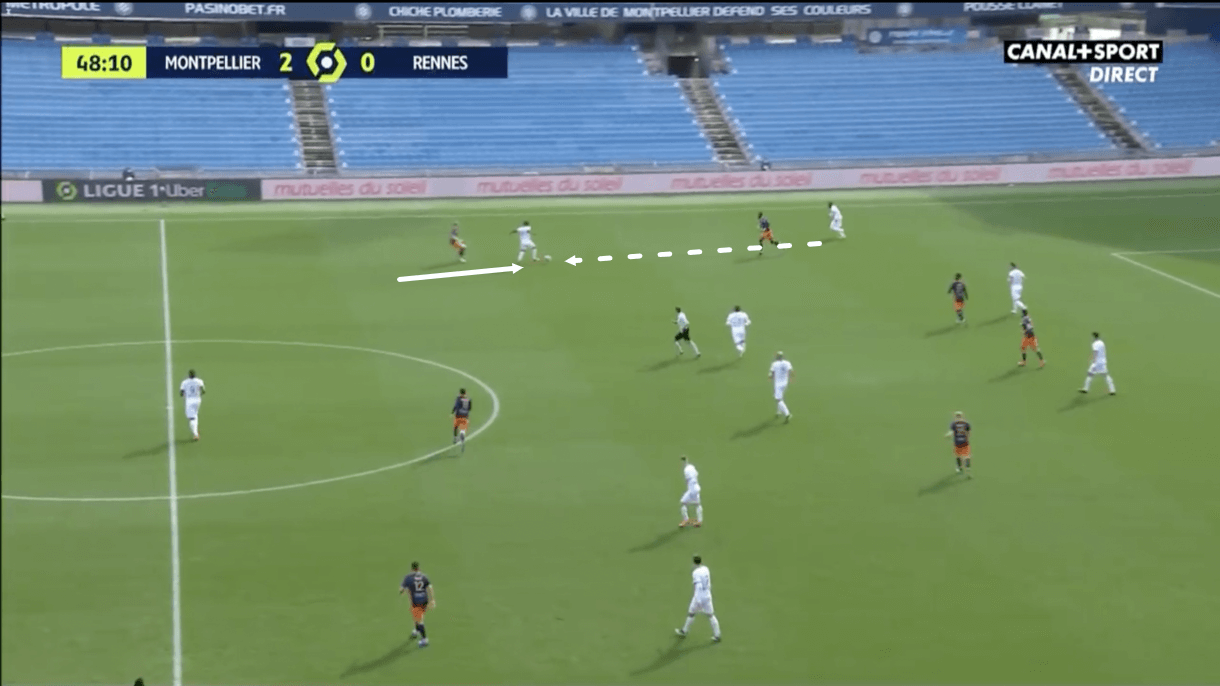
As we see with Jérémy Doku in figure 7, it was common to see Stéphan’s wingers drop deep to help carry the ball upfield both in the ball progression phase and transition to attack. This saw these players take on a lot of dribbles, so their dribbling quality was very important.
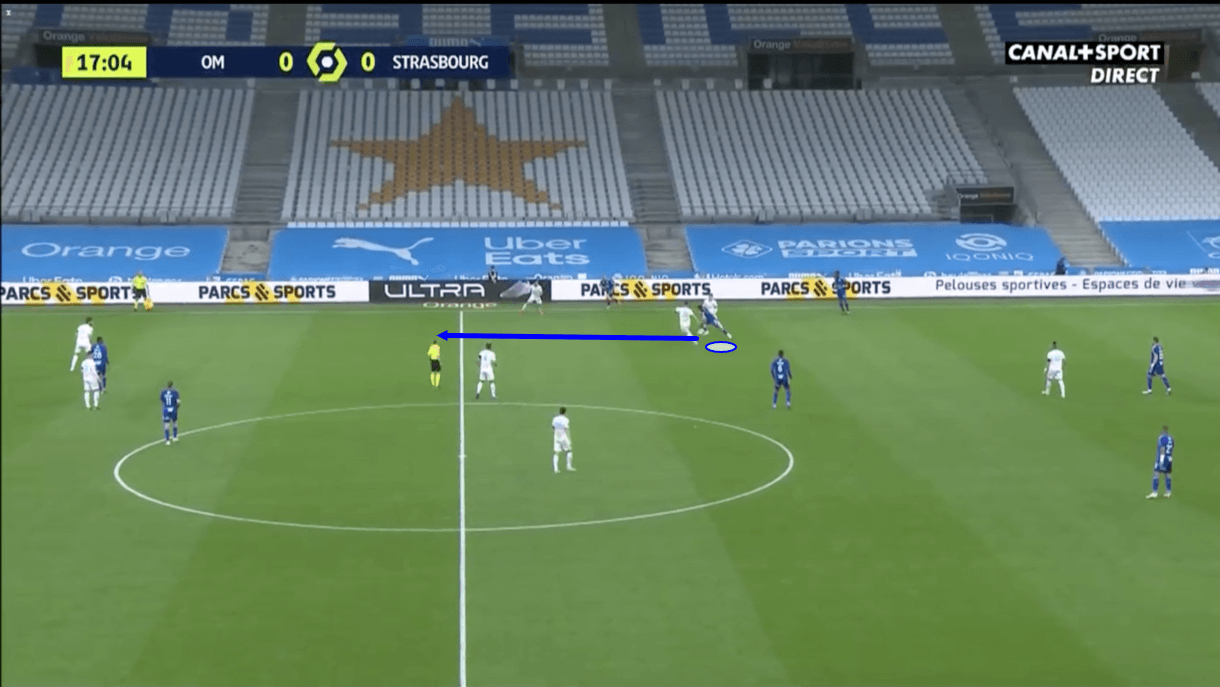
Jean-Ricner Bellegarde is a versatile midfielder who has been utilised on both wings, as well as central midfield during his time at Strasbourg. Notably, he’s a great ball carrier and loves dropping into positions like the one we saw Doku occupying in figure 7, and the one we see Bellegarde occupying in figure 8. We feel he may be best suited to a role on the wing in Stéphan’s system thanks to his ball-carrying tendencies, perhaps on the right, with Habib Diallo on the left, acting as more of a second striker than a true winger.
Stéphan often plays different types of wingers on either side. With Rennes, he utilised Raphinha and, later, Doku as more traditional wingers, while he utilised players like Romain Del Castillo and Martin Terrier more as second strikers coming inside from the left-wing. This is something we expect him to continue with Strasbourg, especially as the personnel available to him make this relatively easy. Bellegarde will dribble a lot and play a lot of crosses, aiming for Ajorque, who’s an excellent target man to have thanks to his aerial dominance. Ajorque can occupy multiple opposition defenders due to his movement and presence, which could create space for Diallo to attack via late runs to the back post. This is something Stéphan utilised at Rennes, with Terrier and Del Castillo making late runs to take advantage of space created by the 9 – usually Niang or Guirassy.
Stéphan’s pressing
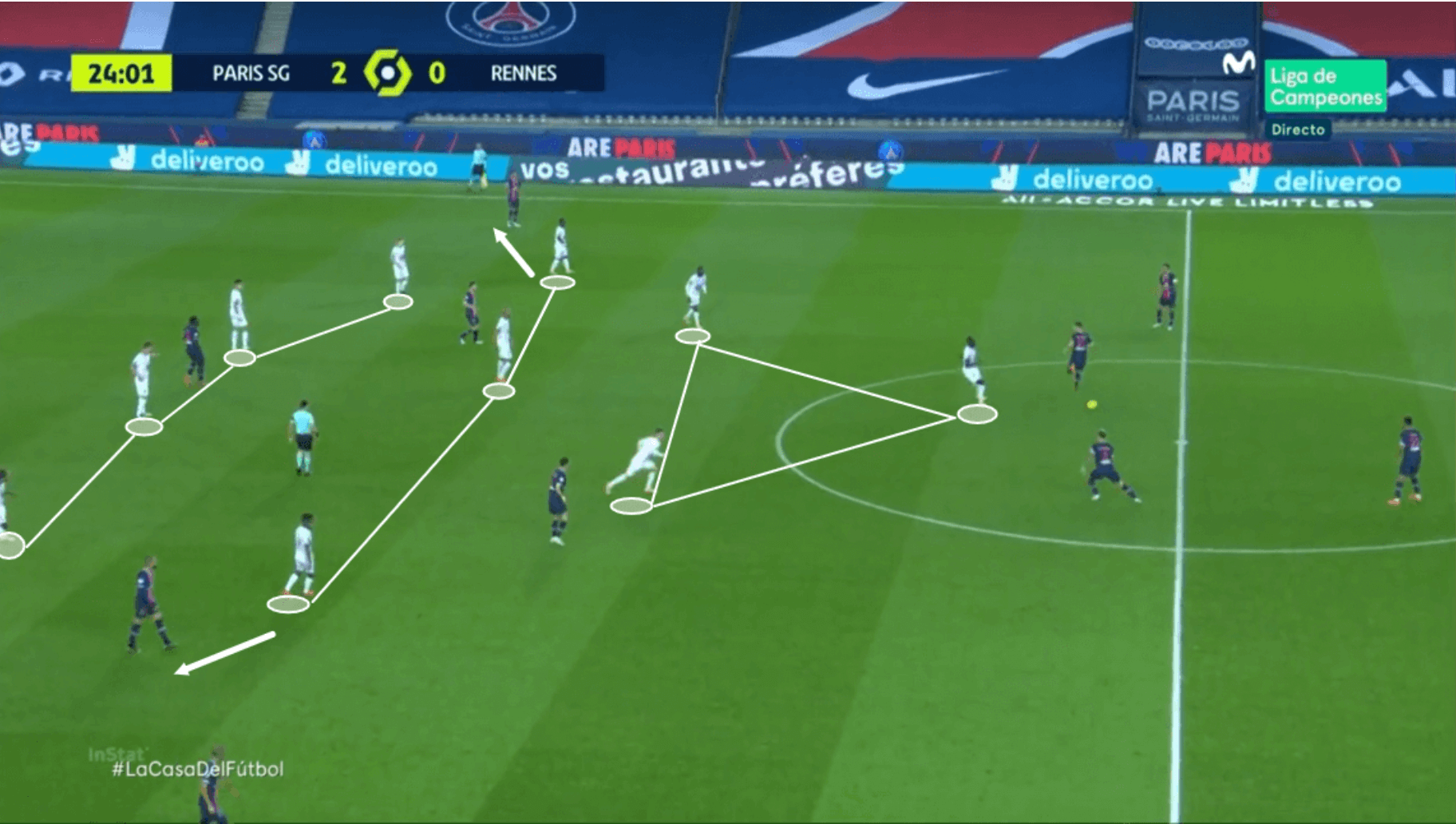
In figure 9, we see a typical example of Stéphan’s defensive shape during a low-block phase. We mentioned earlier that while Stéphan likes his side to press aggressively, he generally prioritises control of the centre above all else and we see how he achieved this by packing central midfield full of bodies here.
Stéphan doesn’t like his side to drop too deep too early, preferring to maintain a fairly high line and compact shape in all defensive phases. The 6 is tasked with covering opposition movement between the lines, while the wingers must sit narrow to provide support centrally, even at the expense of space out wide. However, the wingers do tend to position themselves to maintain access to the oppositions main width-providers – either wingers or full-backs, which can see them drop deeper than the central midfielders in the 4-1-4-1 shape. Meanwhile, Stépan’s 8s sit just ahead of the 6, maintaining access to the opposition’s deep-lying midfielders. Meanwhile, the centre-forward leads the defensive line, often pressing opposition centre-backs or cutting the pitch in half while pressing high.
Regardless of whether Stéphan lines up with a 4-1-4-1, a 4-2-3-1, a 4-4-2, or something different next season with Strasbourg, expect him to set up with a compact shape which prioritises control of the centre and sees the midfield players orientate themselves near enough to press specific opposition players if the ball is played to them, as figure 9 provides an example of, with the right-sided 8 pressing the opposition’s deep, left central midfielder here as he receives a pass.
Prcić and Liénard would be capable of performing the roles of the 8s here, with Bellegarde and Diallo playing as the wingers and Ajorque occupying the centre-forward position, should Stéphan look to play with a 4-1-4-1, however, a 4-4-2/4-2-3-1 with Diallo joining Ajorque centrally and a different player occupying the left-wing position, depending on the holding midfield situation.
In the high block, it’s common for Stéphan’s side to press aggressively, with the attackers and midfielders aggressively moving to mark the opposition ball-carrier’s nearest passing options at all times to give them less clear passing options, making it more difficult for them to pick a pass and to ultimately force a turnover.
Rennes finished the 2020/21 season with the third-lowest PPDA in Ligue 1 (10.72), while Strasbourg had the ninth-highest PPDA in Ligue 1 (14.65). This indicates that Rennes were one of the most aggressive pressing sides in France’s top-flight while Strasbourg pressed with fairly average intensity for the league. So, we’d expect Strasbourg’s pressing intensity to increase under Stéphan – how much it does, again, depends on Stéphan’s comfortability with the holding midfield position.
Conclusion
To conclude this tactical analysis looking at Strasbourg under their new manager, we expect Strasbourg to be more focused on short, accurate passing, make far more dribbles, and press slightly more aggressively next season under Stéphan, while playing less long balls and engaging in fewer aerial duels.
Stéphan will be looking to slowly shift this team to a more possession-based side, but that change isn’t necessarily going to be immediate and likely won’t be. The 2021/22 season will more likely see Strasbourg stay a primarily transition-based side, and as a result, continuing in the 4-2-3-1 which they primarily used last season is a strong possibility. That will depend on Stéphan’s search for his new Nzonzi, however, how long that takes, and whether or not the answer is already at Strasbourg. We feel the answer is not at Strasbourg right now, but the central midfield options of Prcić and Liénard are interesting. They have the right profiles for a Stéphan side, based on what we saw at Rennes, and could be key for Strasbourg next season, along with Bellegarde, Ajorque, and Diallo.
Improvements at holding midfield, full-back, and possibly centre-back will likely be desired by the 40-year-old manager, and Strasbourg’s progression under him will likely be dependent on those players, to an extent.

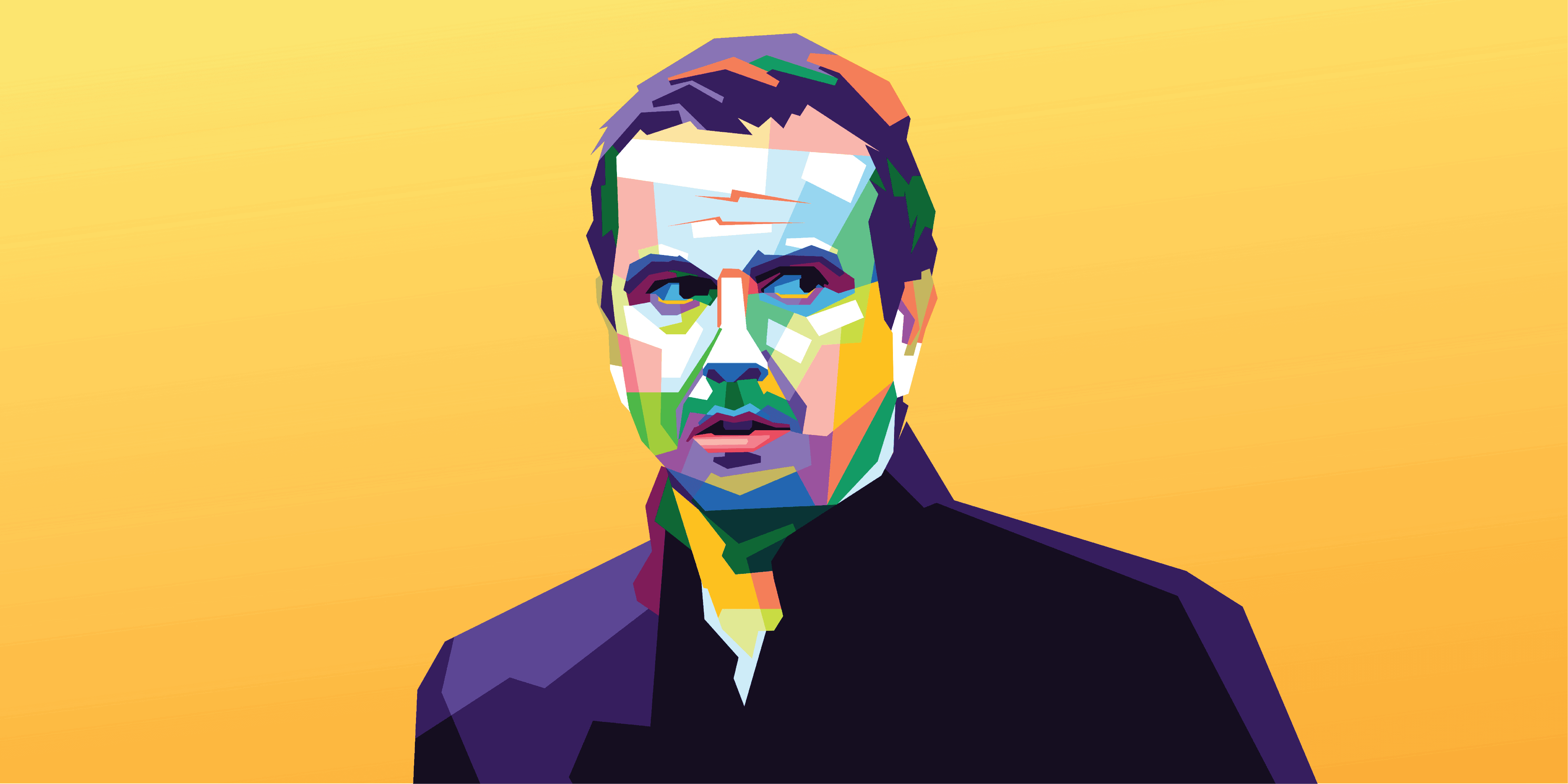



Comments